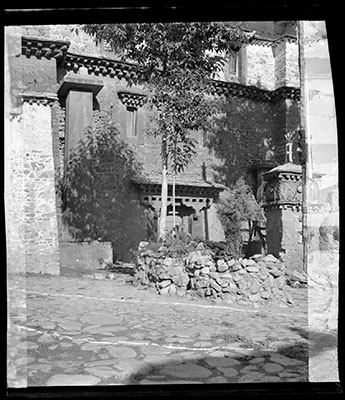
2001.59.15.37.1 (Film negative)


2001.59.15.37.1 (Film negative)

Hugh E. Richardson
Hugh Richardson
Autumn 1948
East Kyichu Valley Region > Zhwa'i lhakhang
2001.59.15.37.1
55 x 55 mm
Negative film nitrate
Donated August 2001
The executors of the estate of Hugh E. Richardson
Richardson's 1948 tour of the East Kyichu Valley
Negative Album 9 No. 37
Manual Catalogues - Notes on negative album (slip cover) - 'Drikhung. Chongye. etc.' in Richardson's hand in white. (Yellow spine label) 'DRIKHUNG. CHONGYE. KOTSHAL. RGYAMA. Ganden 1948'. (Cover) - '9 DRIKHUNG. CHONGYE. YARLUNG. GYAMA. GANDEN' [KC 15/5/2006]
Manual Catalogues - Notes in negative index - Folio 37. 'do' [Zhwa'i Lhakhang] [KC 15/5/2006]
'
Manual Catalogues - Richardson's Handlist, Negative book '9' 'Drikhung, Chongye etc.' [nos] 33-41, 'Xhwa'i Lha-khang is in a side valley on the left bank of the Skyid-chu a short way downstream from Rdzong-gsar. There is a chapel founded in the 9th century and two inscribed pillars of that date. See my article in Journal of the Royal Asiatic Society (JRAS) 1952 and 1953' [KC 17/5/2006]
Research publication - High Peaks, Pure Earth , H. E. Richardson, London, Serindia Publications, 1998, plate 15.
Other Information - Setting: Richardson visited this site in 1948 and 1949 and describes it in High Peaks, Pure Earth , H. E. Richardson, London, Serindia Publications, 1998, p. 307. " ... in the open valley of the Mang-ra-chu, facing the point where the Skyid-chu, flowing from the north, turns sharply westwards, is the little Zhwa'i Lha-khang (1949, 1949), the 'Temple of the Hat'. It is approached through a courtyard where the three resident monks kept their cattle. At either side of the entrance to the temple is a stone pillar, now damaged, bearing inscriptions by Khri Lde-srong-brtsan in honour of the founder, the famous monk-minister Myang Ting-nge-'dzin bzang-po, whose ward and pupil he had been in his minority. A door opens onto a little enclosure with a white mcho-rten in the centre, beyond which could be seen through the open door of the temple the image of Rnam-par snang-mdzad (Vairocana) on the altar with the Eight Disciples of the Buddha on either side. ... the basic structure of the temple appeared to have survived unchanged since the early years of the ninth century. A little way from the building is a white mchod-rten containing the miraculous hat of Myang Ting-nge-'dzin. The legend tells how he had been promised as much grain as would fill his hat: putting his hat, which had a hole in it, over the granary, the grain poured through to provide he wherewithall to build his temple."
Other Information - Location: Richardson describes his visit to Zhwa'i lhakhang in 1948 in 'The Chapel of the Hat', chapter 61 of High Peaks, Pure Earth , London, Serindia Publications, 1998, pp. 722-726. "He [a monk] led us to the doorway of a small but solid three-storeyed building, red-washed stone below and white above. My eyes brightened as I saw two fine stone pillars with writing on them, one on each side of the door. ... They were thickly splashed with the red-wash which covered the walls of the building, so that much of the inscription was illegible. A monk who joined me promised to have it cleaned tomorrow. (p.724) [KC 23/09/2006]
Other Information - Historical background: The translation of the inscriptions on the two pillars may be found in A Corpus of Early Tibetan Inscriptions [ Hertford: Stephen Austin and Son, Royal Asiatic Society, James G. Forlong Series, No. XXIX, 1985, pp. 43-63]. They record priviledges granted at different times "to Ban-de Myang Ting-nge-'dzin who founded the temple and who, as seen from the inscriptions, was the guardian of Khri Lde-srong-brtsan when young and later, as a minister of state, was instrumental in establishing him on the throne." (p.43) [KC 23/09/2006]
Other Information - Dates: The contact print of this image is part of a group made from 6x6 negatives that share the same batch development number [585 printed in black ink]. All of the contact prints processed in this batch seem to have been taken during or around the time of a trip to Drigung Monastery and Zhwai (Sha) Lhakhang, including Tsa Pobrag, Yeregang and Khyer. Photographs from this trip can be dated to 1948. In A Corpus of Early Tibetan Inscriptions [ Hertford: Stephen Austin and Son, Royal Asiatic Society, James G. Forlong Series, No. XXIX, 1985, p.45] Richardson states of the Zhwai inscriptions translated in the book that “The texts, which were first published in JRAS in 1952 and 1954, are based on copies and photographs made by me in 1948 and checked on a second visit in the following year”.
For Citation use:
The Tibet Album.
"West and east inscription pillars at Zhwa'i lhakhang"
05 Dec. 2006. The Pitt Rivers Museum.
<http://tibet.prm.ox.ac.uk/photo_2001.59.15.37.1.html>.
For more information about photographic usage or to order prints, please visit the The Pitt Rivers Museum.
© The Pitt Rivers Museum